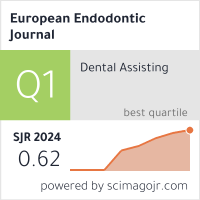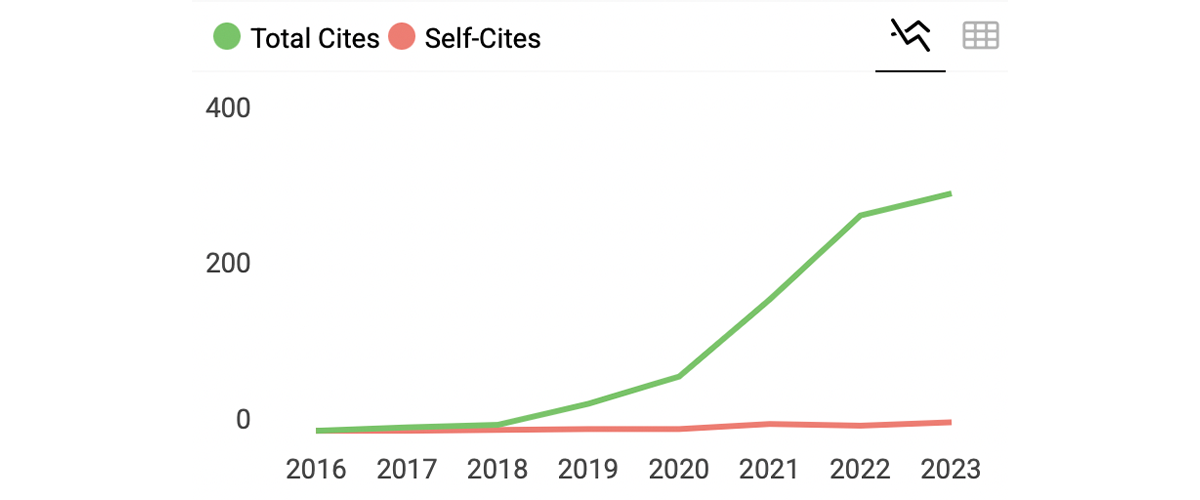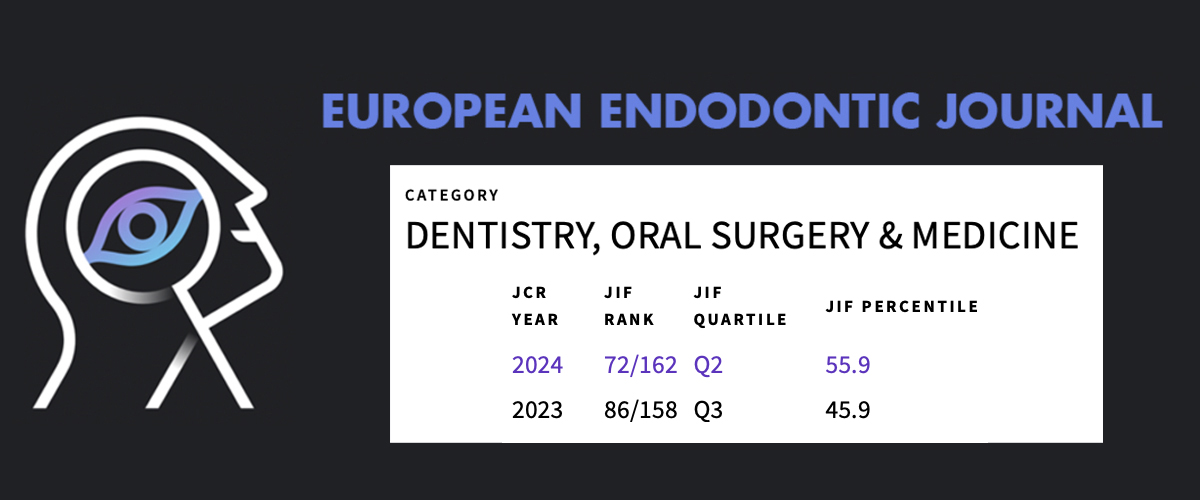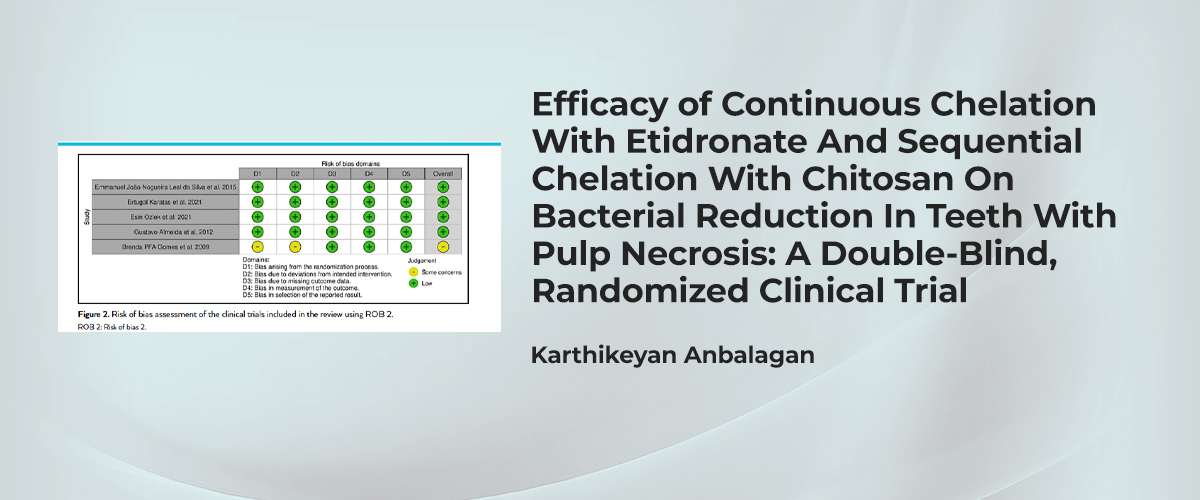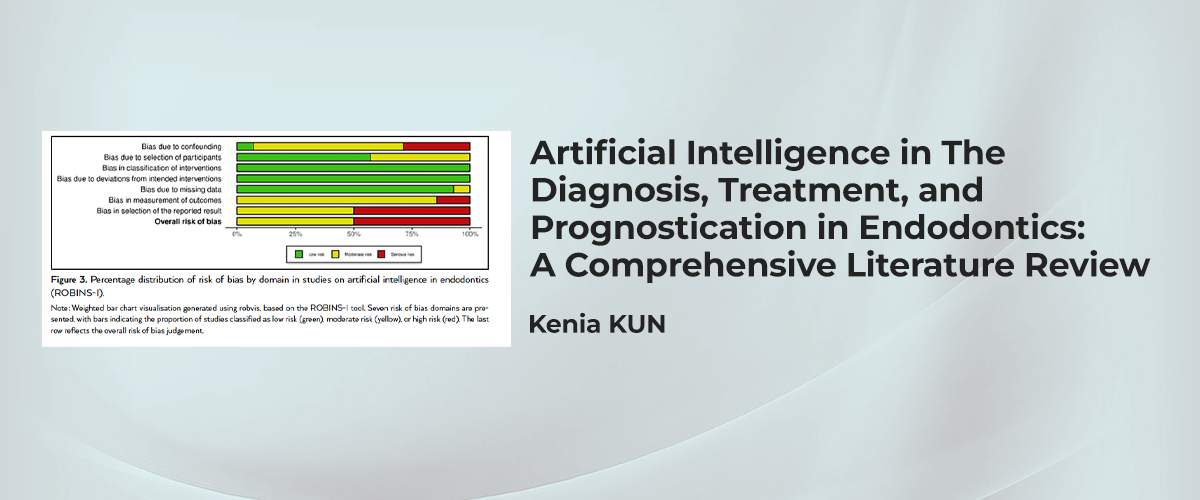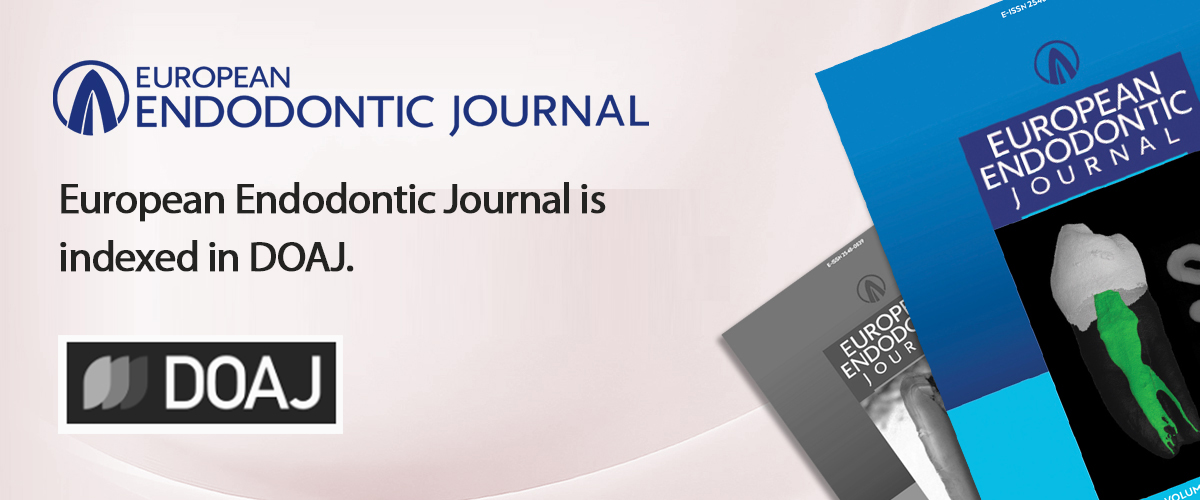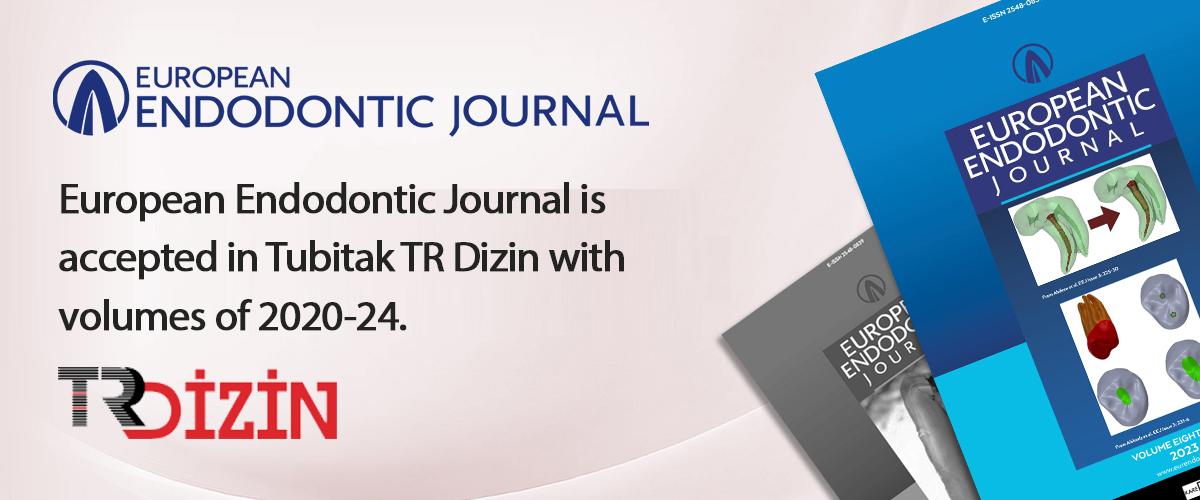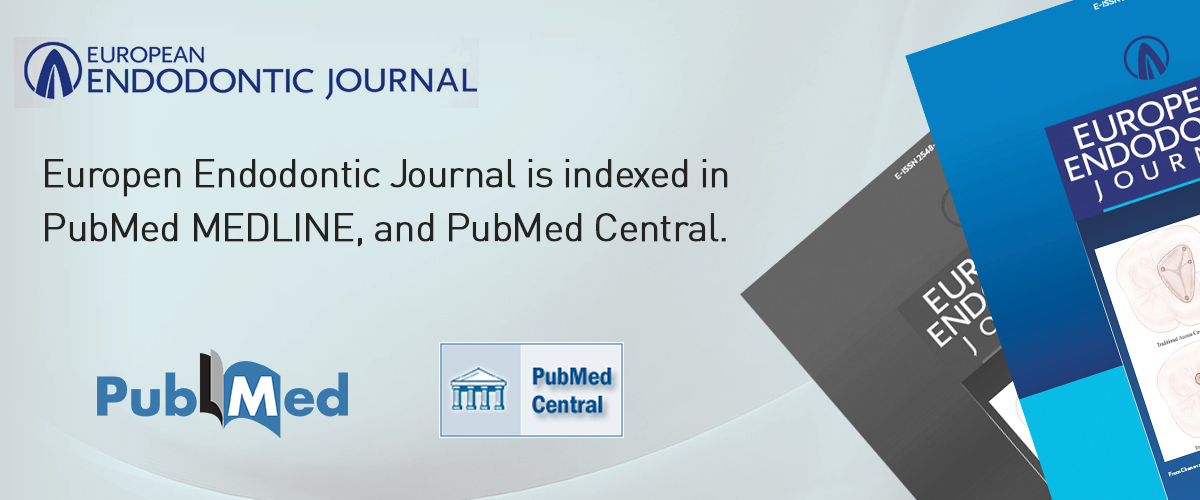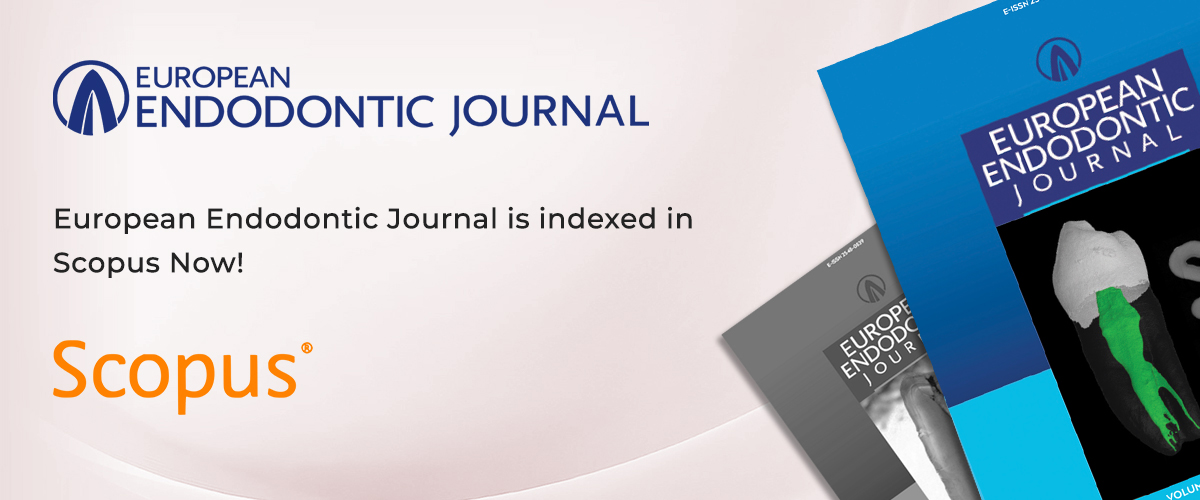Metrics
2024 IMPACT FACTOR
5 year Impact Factor
Eigenfactor Score
2024 CiteScore
Journal Citation Reports
(Clarivate 2025, JIF Rank)
Instructions For Authors
European Endodontic Journal publishes clinical and experimental studies on on all aspects of endodontics, reviews on current topics, case reports, editorial comments and letters to the editor that are prepared in accordance with the ethical guidelines. The journals publication language is English.
The editorial and publication processes of the journal are shaped in accordance with the guidelines of the International Council of Medical Journal Editors (ICMJE), the World Association of Medical Editors (WAME), the Council of Science Editors (CSE), the Committee on Publication Ethics (COPE), the European Association of Science Editors (EASE), and National Information Standards Organization (NISO). The journal conforms to the Principles of Transparency and Best Practice in Scholarly Publishing (doaj.org/bestpractice).
Originality, high scientific quality, and citation potential are the most important criteria for a manuscript to be accepted for publication. Manuscripts submitted for evaluation should not have been previously presented or already published in an electronic or printed medium. Manuscripts that have been presented in a meeting should be submitted with detailed information on the organization, including the name, date, and location of the organization.
Manuscripts submitted to European Endodontic Journal will go through a double-blind peer-review process. Each submission will be reviewed by at least two external, independent peer reviewers who are experts in their fields in order to ensure an unbiased evaluation process. The editorial board will invite an external and independent editor to manage the evaluation processes of manuscripts submitted by editors or by the editorial board members of the journal. The Editor in Chief is the final authority in the decision-making process for all submissions.
An approval of research protocols by the Ethics Committee in accordance with international agreements (World Medical Association Declaration of Helsinki Ethical Principles for Medical Research Involving Human Subjects, amended in October 2013, www.wma.net) is required for experimental, clinical, and drug studies and for some case reports. If required, ethics committee reports or an equivalent official document will be requested from the authors. For manuscripts concerning experimental research on humans, a statement should be included that shows that written informed consent of patients and volunteers was obtained following a detailed explanation of the procedures that they may undergo. For studies carried out on animals, the measures taken to prevent pain and suffering of the animals should be stated clearly. Information on patient consent, the name of the ethics committee, and the ethics committee approval number should also be stated in the Materials and Methods section of the manuscript. It is the authors responsibility to carefully protect the patients anonymity. For photographs that may reveal the identity of the patients, releases signed by the patient or their legal representative should be enclosed.
Authors who used AI technology to conduct the study should describe its use in this section in sufficient detail to enable replication to the approach, including the tool used, version, and prompts where applicable.
All submissions are screened by a similarity detection software (iThenticate by CrossCheck).
In the event of alleged or suspected research misconduct, e.g., plagiarism, citation manipulation, and data falsification/fabrication, the Editorial Board will follow and act in accordance with COPE guidelines.
Each individual listed as an author should fulfil the authorship criteria recommended by the International Committee of Medical Journal Editors
(ICMJE - www.icmje.org). The ICMJE recommends that authorship be based on the following 4 criteria:
1. Substantial contributions to the conception or design of the work; or the acquisition, analysis, or interpretation of data for the work; AND
2. Drafting the work or revising it critically for important intellectual content; AND
3. Final approval of the version to be published; AND
4. Agreement to be accountable for all aspects of the work in ensuring that questions related to the accuracy or integrity of any part of the work are appropriately investigated and resolved.
In addition to being accountable for the parts of the work he/she has done, an author should be able to identify which co-authors are responsible for specific other parts of the work. In addition, authors should have confidence in the integrity of the contributions of their co-authors.
All those designated as authors should meet all four criteria for authorship, and all who meet the four criteria should be identified as authors. Those who do not meet all four criteria should be acknowledged in the title page of the manuscript.
Declaration of Artificial Intelligence (AI)Assisted Technology in Scientific Writing
At submission, authors should disclose whether they used artificial intelligence (AI) assisted technologies (such as Large Language Models [LLMs], chatbots, or image creators) in the production of submitted work. Authors who use such technology should describe, in both the Title Page and the submitted work, how they used it. Authors who used AI technology to conduct the study should describe its use in the methods section in sufficient detail to enable replication to the approach, including the tool used, version, and prompts where applicable. Chatbots (such as ChatGPT) and AI assisted technologies should not be listed as an author or co-author nor cited because they cannot be responsible for the accuracy, integrity, and originality of the work, and these responsibilities are required for authorship. Therefore, humans are responsible for any submitted material that included the use of AI-assisted technologies. Authors should carefully review and edit the result because AI can generate authoritative-sounding output that can be incorrect, incomplete, or biased. Authors should be able to assert that there is no plagiarism in their paper, including in text and images produced by the AI. Humans must ensure there is appropriate attribution of all quoted material, including full citations.
European Endodontic Journal requires corresponding authors to submit a signed and scanned version of the authorship contribution form (available for download through www.eurendodj.com) during the initial submission process in order to act appropriately on authorship rights and to prevent ghost or honorary authorship. If the editorial board suspects a case of gift authorship, the submission will be rejected without further review. As part of the submission of the manuscript, the corresponding author should also send a short statement declaring that he/she accepts to undertake all the responsibility for authorship during the submission and review stages of the manuscript.
European Endodontic Journal requires and encourages the authors and the individuals involved in the evaluation process of submitted manuscripts to disclose any existing or potential conflicts of interests, including financial, consultant, and institutional, that might lead to potential bias or a conflict of interest. Any financial grants or other support received for a submitted study from individuals or institutions should be disclosed to the Editorial Board. To disclose a potential conflict of interest, the ICMJE Potential Conflict of Interest Disclosure Form should be filled in and submitted by all contributing authors. Cases of a potential conflict of interest of the editors, authors, or reviewers are resolved by the journals Editorial Board within the scope of COPE and ICMJE guidelines.
The Editorial Board of the journal handles all appeal and complaint cases within the scope of COPE guidelines. In such cases, authors should get in direct contact with the editorial office regarding their appeals and complaints. When needed, an ombudsperson may be assigned to resolve cases that cannot be resolved internally. The Editor in Chief is the final authority in the decision-making process for all appeals and complaints.
Statements or opinions expressed in the manuscripts published in European Endodontic Journal reflect the views of the author(s) and not the opinions of the editors, the editorial board, or the publisher; the editors, the editorial board, and the publisher disclaim any responsibility or liability for such materials. The final responsibility in regard to the published content rests with the authors.
Submission Charges: The journal has no article submission charges.
Article Processing Charges (APCs): European Endodontic Journal levies an article-processing charge of 750 for each article accepted for publication.
No APC fee is charged for letters to the editor that are no more than two pages in length.
The APC is payable when your manuscript is editorially accepted and before publication. The corresponding author of the manuscript is responsible for making the payment upon editorial acceptance of the manuscript. Prompt payment is recommended since we cannot publish accepted manuscripts until payment has been received.
An article-processing charge (APC) covers the range of publishing services including article production and hosting, copyediting, typesetting, publication on our website, and marketing, as well as technical development and maintenance of the publishing platform.
Authors can complete the APC process after depositing 750.- to the Euro account. The article number and corresponding author name must be written in the bank shipment description section. Authors are responsible for any bank transfer costs.
Note: A 750 article processing charge will be requested for manuscripts initially submitted on or after November 01, 2025, and subsequently accepted for publication following peer review.
The manuscripts should be prepared in accordance with ICMJE-Recommendations for the Conduct, Reporting, Editing, and Publication of Scholarly Work in Medical Journals (updated in December 2016 - http://www.icmje.org/icmje-recommendations.pdf). Authors are required to prepare manuscripts in accordance with the CONSORT guidelines for randomized research studies, STROBE guidelines for observational original research studies, STARD guidelines for studies on diagnostic accuracy, PRISMA guidelines for systematic reviews and meta-analysis, ARRIVE guidelines for experimental animal studies, and TREND guidelines for non-randomized public behaviour.
Manuscripts can only be submitted through the journals online manuscript submission and evaluation system, available at www.eurendodj.com. Manuscripts submitted via any other medium will not be evaluated.
Manuscripts submitted to the journal will first go through a technical evaluation process where the editorial office staff will ensure that the manuscript has been prepared and submitted in accordance with the journals guidelines. Submissions that do not conform to the journals guidelines will be returned to the submitting author with technical correction requests.
Authors are required to submit the following:
- Copyright Transfer Form,
- Author Contributions Form, and
- ICMJE Potential Conflict of Interest Disclosure Form (should be filled in by all contributing authors) during the initial submission. These forms are available for download at www.eurendodj.com.
Title page: A separate title page should be submitted with all submissions and this page should include:
- The full title of the manuscript as well as a short title (running head) of no more than 50 characters,
- Name(s), affiliations, and highest academic degree(s) of the author(s),
- Grant information and detailed information on the other sources of support,
- Name, address, telephone (including the mobile phone number) and fax numbers, and email address of the corresponding author,
- Acknowledgment of the individuals who contributed to the preparation of the manuscript but who do not fulfill the authorship criteria.
- Authors should disclose whether they used artificial intelligence (AI) assisted technologies (such as Large Language Models [LLMs], chatbots, or image creators) in the production of submitted work. Authors should assert that there is no plagiarism in their paper, including in text and images produced by the AI -if any- and must ensure there is appropriate attribution of all quoted material, including full citations. Authors who used AI technology to conduct the study should describe its use in the methods section in sufficient detail.
Abstract: An abstract should be submitted with all submissions except for Letters to the Editor. The abstract of Original Articles should be structured with subheadings (Objective, Methods, Results, and Conclusion). Please check Table 1 below for word count specifications.
Keywords: Each submission must be accompanied by a minimum of three to a maximum of six keywords for subject indexing at the end of the abstract. The keywords should be listed in full without abbreviations. The keywords should be selected from the National Library of Medicine, Medical Subject Headings database (https://www.nlm.nih.gov/mesh/MBrowser.html).
Manuscript TypesOriginal Articles: This is the most important type of article since it provides new information based on original research. The main text of original articles should be structured with Introduction, Methods, Results, Discussion, and Conclusion subheadings. Please check Table 1 for the limitations for Original Articles.
Statistical analysis to support conclusions is usually necessary. Statistical analyses must be conducted in accordance with international statistical reporting standards (Altman DG, Gore SM, Gardner MJ, Pocock SJ. Statistical guidelines for contributors to medical journals. Br Med J 1983: 7; 1489-93). Information on statistical analyses should be provided with a separate subheading under the Materials and Methods section and the statistical software that was used during the process must be specified.
Units should be prepared in accordance with the International System of Units (SI).
Review Articles: Reviews prepared by authors who have extensive knowledge on a particular field and whose scientific background has been translated into a high volume of publications with a high citation potential are welcomed. These authors may even be invited by the journal. Reviews should describe, discuss, and evaluate the current level of knowledge of a topic in clinical practice and should guide future studies. The main text should contain Introduction, Clinical and Research Consequences, and Conclusion sections. Please check Table 1 for the limitations for Review Articles.
Case Reports, Case Series and Literature of Review: There is limited space for case reports in the journal and reports on rare cases or conditions that constitute challenges in diagnosis and treatment, those offering new therapies or revealing knowledge not included in the literature, and interesting and educative case reports are accepted for publication. The text should include Introduction, Case Presentation, Discussion, and Conclusion subheadings. Please check Table 1 for the limitations for Case Reports.
Letters to the Editor: This type of manuscript discusses important parts, overlooked aspects, or lacking parts of a previously published article. Articles on subjects within the scope of the journal that might attract the readers attention, particularly educative cases, may also be submitted in the form of a Letter to the Editor. Readers can also present their comments on the published manuscripts in the form of a Letter to the Editor. Abstract, Keywords, and Tables, Figures, Images, and other media should not be included. The text should be unstructured. The manuscript that is being commented on must be properly cited within this manuscript.
Table 1. Limitations for each manuscript type|
Type of manuscript |
Word limit |
Abstract word limit |
Reference limit |
Table limit |
Figure limit |
|
Original Article |
3500 |
350 (Structured) |
40 |
6 |
5 or total of 15 images |
|
Review Article |
5000 |
350 |
None |
6 |
10 or total of 20 images |
|
Case Report |
1000 |
200 |
25 |
No tables |
5 or total of 15 images |
|
Case Series |
2000 |
200 |
25 |
10 or total of 20 images |
10 or total of 20 images |
|
Letter to the Editor |
500 |
No abstract |
5 |
No tables |
No media |
Tables
Tables should be included in the main document, presented after the reference list, and they should be numbered consecutively in the order they are referred to within the main text. A descriptive title must be placed above the tables. Abbreviations used in the tables should be defined below the tables by footnotes (even if they are defined within the main text). Tables should be created using the insert table command of the word processing software and they should be arranged clearly to provide easy reading. Data presented in the tables should not be a repetition of the data presented within the main text but should be supporting the main text.
Figures and Figure Legends
Figures, graphics, and photographs should be submitted as separate files (in TIFF or JPEG format) through the submission system. The files should not be embedded in a Word document or the main document. When there are figure subunits, the subunits should not be merged to form a single image. Each subunit should be submitted separately through the submission system. Images should not be labelled (a, b, c, etc.) to indicate figure subunits. Thick and thin arrows, arrowheads, stars, asterisks, and similar marks can be used on the images to support figure legends. Like the rest of the submission, the figures too should be blind. Any information within the images that may indicate an individual or institution should be blinded. The minimum resolution of each submitted figure should be 300 DPI. To prevent delays in the evaluation process, all submitted figures should be clear in resolution and large in size (minimum dimensions: 100 × 100 mm). Figure legends should be listed at the end of the main document.
All acronyms and abbreviations used in the manuscript should be defined at first use, both in the abstract and in the main text. The abbreviation should be provided in parentheses following the definition.
When a drug, product, hardware, or software program is mentioned within the main text, product information, including the name of the product, the producer of the product, and city and the country of the company (including the state if in USA), should be provided in parentheses in the following format: Discovery St PET/CT scanner (General Electric, Milwaukee, WI, USA)
All references, tables, and figures should be referred to within the main text, and they should be numbered consecutively in the order they are referred to within the main text.
Limitations, drawbacks, and the shortcomings of original articles should be mentioned in the Discussion section before the conclusion paragraph.
Please note that British English spelling and terminology should be used in the manuscripts.
Highlights
Each submission should be accompanied by 3 to 5 highlight points which should emphasize the most striking results of the study and highlight the message that is intended to be conveyed to the readers. As these highlights would be targeting endodontics residents, experts and residents of other fields of medicine, as well as endodontics experts, they should be kept as plain and simple as possible. These points should be constructed in a way that provides the readers with a general overview of the article and enables them to have a general idea about the article. The highlights should be listed at the end of the main text, above the reference list.
References
While citing publications, preference should be given to the latest, most up-to-date publications. If an ahead-of-print publication is cited, the DOI number should be provided. Authors are responsible for the accuracy of references. Journal titles should be abbreviated in accordance with the journal abbreviations in Index Medicus/ MEDLINE/PubMed. When there are 6 or fewer authors, all authors should be listed. If there are 7 or more authors, the first 6 authors should be listed followed by et al. In the main text of the manuscript, references should be cited using Arabic numbers in parentheses. The reference styles for different types of publications are presented in the following examples.
Journal Article:
Author. Title. Journal Year|;Volume|(Issue)|:Pages|.
Rankovic A, Rancic N, Jovanovic M, Ivanovic M, Gajovic O, Lazic Z, et al. Impact of imaging diagnostics on the budget Are we spending too much? Vojnosanit Pregl 2013; 70(7): 709-11.
Book Section:
Author. Title. In:| Editor, `editor`.^`editors`.| Book Title|. Edition ed|. Place Published|: Publisher|; Year|. p. Pages|.
Suh KN, Keystone JS. Malaria and babesiosis In: Gorbach SL, Barlett JG, Blacklow NR, editors. Infectious Diseases. 3th ed . Philadelphia: Lippincott Williams; 2004. p.2290-308.
Books with a Single Author:
Author. Title|. Edition ed|. Place Published|: Publisher|; Year|.
Sweetman SC. Martindale the Complete Drug Reference. 34th ed. London: Pharmaceutical Press; 2005.
Conference Proceedings:
Author. Title. In:| Editor, `editor`.^`editors`.| Conference Name|; Year of Conference| Date|; Conference Location|: Publisher|; Year of Conference|. p. Pages|.
Bengisson S. Sothemin BG. Enforcement of data protection, privacy and security in medical informatics. In: Lun KC, Degoulet P, Piemme TE, Rienhoff O, editors. MEDINFO 92. Proceedings of the 7th World Congress on Medical Informatics; 1992 Sept 6-10; Geneva, Switzerland. Amsterdam: North-Holland; 1992. pp.1561-5.
Scientific or Technical Report:
Author. Title|. Type|. Place Published|: Institution|; Year| Date|. Report No.: Report Number|.
Cusick M, Chew EY, Hoogwerf B, Agrón E, Wu L, Lindley A, et al. Early Treatment Diabetic Retinopathy Study Research Group. Risk factors for renal replacement therapy in the Early Treatment Diabetic Retinopathy Study (ETDRS), Early Treatment Diabetic Retinopathy Study Kidney Int: 2004. Report No: 26.
Thesis:
Author. Title|. Type|. Place Published|: Institution|; Year| Date|. Report No.: Report Number|.
Kaplan SI. Post-hospital home health care: elderly access and utilization (dissertation). St Louis (MO): Washington Univ; 1995.
Epub Ahead of Print Articles:
Author. Title. Alternate Title Year| Date Accessed. doi: DOI. [Epub ahead of print].
Cai L, Yeh BM, Westphalen AC, Roberts JP, Wang ZJ. Adult living donor liver imaging. Diagn Interv Radiol. 2016 Feb 24. doi: 10.5152/dir.2016.15323. [Epub ahead of print].
Webpage:
Author. Title. Available at: URL. Accessed Access Date, Access Year.
REVISIONS
When submitting a revised version of a paper, the author must submit a detailed Response to the reviewers that states point by point how each issue raised by the reviewers has been covered and where it can be found (each reviewers comment, followed by the authors reply and line numbers where the changes have been made) as well as an annotated copy of the main document. Revised manuscripts must be submitted within 60 days from the date of the decision letter. If the revised version of the manuscript is not submitted within the allocated time, the revision option may be cancelled. If the submitting author(s) believe that additional time is required, they should request this extension before the initial 30-day period is over.
Accepted manuscripts are copy-edited for grammar, punctuation, and format. A PDF proof of the accepted manuscript is sent to the corresponding author and their publication approval is requested within 2 days of their receipt of the proof. Once the publication process of a manuscript is completed, it is published online on the journals webpage.
Open Access and Commons User Licenses
Open Access
The European Endodontic Journal is an open access journal which
means that all content is freely available without charge to the user or
his/her institution. Users are allowed to read, download, copy, distribute,
print, search, or link to the full texts of the articles, or use them for
any other lawful purpose, without asking prior permission from the publisher
or the author. This is in accordance with the BOAI definition of open
access.
Commons User Licenses
This work is licensed under a Creative Commons Attribution-NonCommercial 4.0 International License (CC BY-NC 4.0) .


